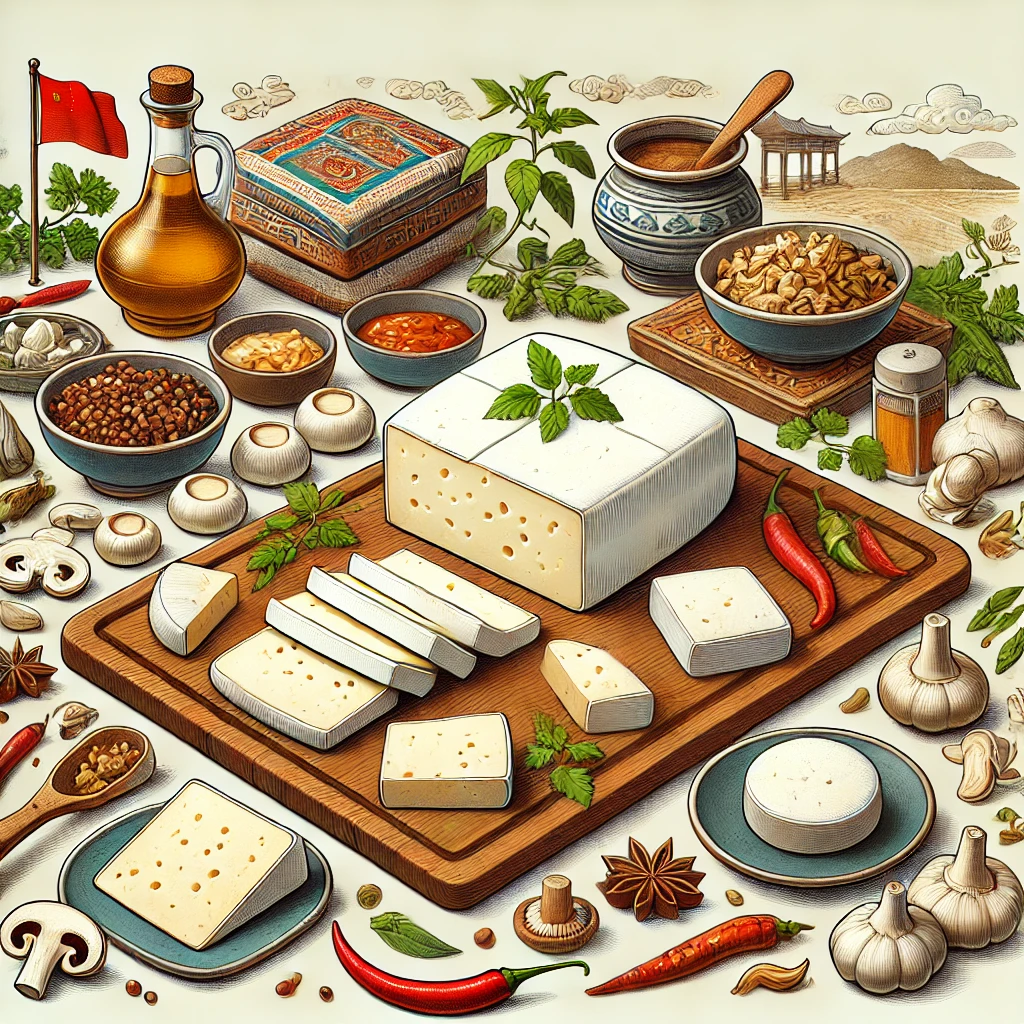China is not widely known as a cheese-producing nation, yet its southwestern province of Yunnan has a rich and fascinating dairy tradition. Among its most iconic foods is Rubing, a fresh, mild, and delicately flavored cheese made primarily by the Bai and Sani (Yi) ethnic communities. Often compared to paneer or halloumi, Rubing is one of China’s oldest cheeses, crafted using techniques passed down through generations in highland villages.
Soft, pure white, and incredibly versatile, Rubing plays an essential role in local cuisine—appearing in stir-fries, grilled dishes, soups, and even sweet preparations. Its simple elegance, firm texture, and subtle dairy sweetness make it a culinary gem that continues to gain recognition worldwide.
This comprehensive guide explores the origins, production methods, taste profile, culinary uses, cultural importance, storage tips, pairings, and everything else you need to know about this remarkable cheese from Yunnan.
🧀 What Is Rubing?
Rubing (乳饼), also called “milk cake,” is a fresh, non-melting cheese typically made from goat’s or cow’s milk. Unlike Western cheeses that rely on rennet or bacterial cultures, Rubing is traditionally coagulated using a plant-based souring agent—the juice of a local vine called ruo dou cao.
Key Characteristics
| Feature | Description |
|---|---|
| Milk | Goat or cow |
| Type | Fresh, non-aged cheese |
| Flavor | Mild, milky, slightly tangy |
| Texture | Firm, smooth, sliceable |
| Color | Pure white |
| Cooking style | Stir-fried, grilled, steamed, pan-seared |
Rubing’s ability to hold its shape during cooking makes it perfect for both savory and sweet dishes.
🌄 Origins & Cultural Significance
Yunnan’s mountainous terrain and diverse ethnic cultures fostered unique food traditions. Dairy consumption is much more common here than in most other regions of China.
Historical Roots
Rubing dates back centuries and is believed to have originated among:
-
the Bai people in Dali
-
the Sani (Yi) people in the Stone Forest region
These communities domesticated goats early and developed cheesemaking as a way to preserve excess milk in warm climates.
Cultural Importance
-
served during festivals, weddings, and family gatherings
-
symbolizes hospitality and abundance
-
made using ancestral plant-based coagulation techniques
-
featured in local markets and street food scenes
Rubing remains a point of pride in Yunnan’s culinary identity.
🥛 How Rubing Is Made
Traditional Rubing is crafted through a simple yet unique process that emphasizes natural ingredients and minimal aging.
1. Milk Heating
Fresh goat or cow milk is heated gently until warm but not boiling.
2. Plant-Based Coagulation
The juice of ruo dou cao (a local vine) or souring leaves is added to curdle the milk. This method:
-
produces a mild, natural tang
-
avoids strong rennet flavors
3. Curd Cutting
Curds are cut into small pieces to release whey.
4. Draining
Curds are scooped into cheesecloth or molds, allowing whey to drain slowly.
5. Pressing
Weights are added to give Rubing its firm, smooth texture.
6. Shaping
Cheese is formed into flat squares or thick discs.
7. Ready to Eat
Rubing is not aged and is eaten fresh within days of production.
Some modern producers use vinegar or lemon juice as a coagulant, but traditional methods remain highly valued.
🧂 Taste & Texture Profile
Rubing’s appeal lies in its pure, subtle flavors and pleasant firmness.
Flavor Notes
-
fresh and milky
-
slightly tangy (depending on plant coagulant)
-
gentle sweetness
-
clean dairy aroma
Texture Notes
-
smooth and dense
-
sliceable
-
similar to paneer but more elastic
-
does not melt when heated
Rubing provides a neutral canvas for bold regional seasonings and sauces.
🍽 Culinary Uses in Yunnan Cuisine
Rubing is incredibly versatile and enjoyed in both home-cooked meals and restaurant dishes throughout Yunnan.
⭐ Traditional Preparations
1. Stir-Fried Rubing with Tomatoes (番茄炒乳饼)
One of the most beloved dishes—juicy tomatoes complement Rubing’s creamy texture.
2. Grilled Rubing Skewers
A popular street food:
-
lightly charred
-
sprinkled with chili, cumin, and salt
3. Pan-Fried Rubing
Sliced and fried until golden on the outside, soft on the inside.
4. Steamed Rubing with Herbs
A mild, comforting preparation flavored with local aromatics.
⭐ In Bai and Yi Cuisine
-
mixed into noodle dishes
-
served with chili oil
-
included in festival meals
⭐ Desserts Featuring Rubing
In some regions, Rubing is sweetened and served with:
-
honey
-
brown sugar syrup
-
Yunnan rose preserves
Its adaptability makes it suitable for both savory and sweet recipes.
🌿 Modern & International Uses
Chefs worldwide enjoy experimenting with Rubing because of its firm, non-melting qualities.
Modern Uses Include:
-
grilled cheese salads
-
fusion tacos
-
stir-fry bowls
-
cheese-and-vegetable skewers
-
baked Rubing appetizers
-
Rubing with pesto or herb oils
Rubing’s mildness means it absorbs marinades extremely well.
🥂 Best Pairings for Rubing
Food Pairings
| Food | Why It Works |
|---|---|
| Tomatoes | acidity brightens the cheese |
| Chili oil | adds heat and complexity |
| Mushrooms | earthy flavors complement mild cheese |
| Stir-fried greens | balances richness |
| Honey or rose jam | ideal for sweet versions |
Beverage Pairings
-
jasmine tea
-
green tea
-
rice wine
-
light white wines (Riesling, Vinho Verde)
-
wheat beers
Refreshing beverages highlight Rubing’s delicate flavor.
🧊 Storage & Shelf Life
Because Rubing is fresh, it has a shorter shelf life.
Storage Guidelines
-
Refrigerate immediately after purchase
-
Keep wrapped in cheese paper or a breathable container
-
Avoid airtight plastic to prevent spoilage
Shelf Life
| Condition | Duration |
|---|---|
| Fresh, refrigerated | 3–5 days |
| Vacuum-sealed | up to 10 days |
| Cooked dishes | 1–2 days |
Rubing is best enjoyed as fresh as possible.
🌏 Rubing Compared to Other Fresh Asian Cheeses
| Cheese | Region | Similarity | Difference |
|---|---|---|---|
| Paneer | India | firm, non-melting | paneer is usually salt-free |
| Halloumi | Cyprus | good for grilling | halloumi is saltier and chewier |
| Tofu | East Asia | mild, versatile | tofu is soy-based, softer |
| Queso Blanco | Latin America | similar firmness | different curdling method |
Rubing stands out for its plant-based coagulation, making its flavor uniquely herbal and mild.
⭐ Cultural Importance
Rubing is more than a cheese—it is a bridge between ancient practice and modern gastronomy, symbolizing:
-
ethnic diversity
-
pastoral life in Yunnan
-
sustainable and natural food traditions
-
community-based production
The cheese highlights the unique blend of biodiversity and culinary heritage in southwest China.
⭐ Conclusion
Rubing cheese from Yunnan is a remarkable expression of Chinese regional cuisine. Fresh, firm, and subtly tangy, it showcases the traditions of the Bai and Sani people while offering extraordinary versatility in both classic and modern dishes. Whether grilled, stir-fried, or paired with sweet floral flavors, Rubing is a cheese that surprises, delights, and represents Yunnan’s culinary soul.
As global interest in artisan and ethnic cheeses grows, Rubing stands poised to become a favorite among food enthusiasts seeking authentic, culturally rich ingredients.
FAQs – Rubing Cheese
1. What milk is Rubing made from?
Traditionally goat milk, but cow milk is also widely used today.
2. Does Rubing melt?
No—Rubing is a non-melting cheese ideal for grilling and stir-frying.
3. How is Rubing traditionally eaten?
Pan-fried, grilled, or stir-fried with tomatoes and local spices.
4. What makes Rubing unique?
Its plant-based coagulation method and mild, herbal flavor.
5. Is Rubing available outside China?
It is limited but increasingly found in specialty Asian grocery stores and restaurants.






